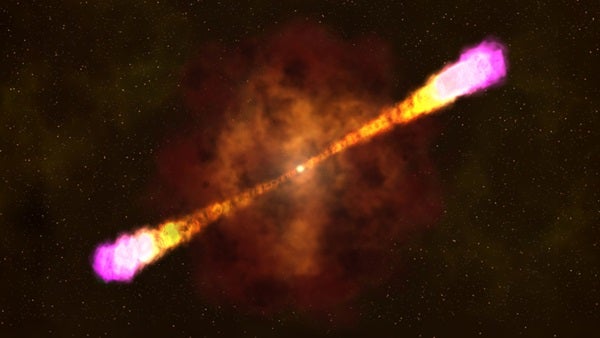The Swift satellite has found a gamma-ray burst from a star that died when the universe was 640 million years old, or less than 5 percent of its present age. The event, called GRB 090423, is the most distant cosmic explosion ever seen and gives astronomers an insight into the early universe. The international team, led by United Kingdom and United States astronomers, announced the discovery today.
“This is the most remote gamma-ray burst ever detected, and also the most distant object ever discovered – by some way,” said Nial Tanvir of the University of Leicester.
“At its most basic level, this discovery tells us that there were massive stars at this moment in cosmic history,” said Andrew Levan of the University of Warwick. “Equally important, we can use events like this to probe how the universe evolves when it is less than 5 percent of its current age.”
“The burst most likely arose from the explosion of a massive star,” said Derek Fox at Penn State University in University Park. “We’re seeing the demise of a star – and probably the birth of a black hole – in one of the universe’s earliest stellar generations.”
“Swift was designed to catch these very distant bursts,” said Neil Gehrels, Swift lead scientist at NASA’s Goddard Space Flight Center, Greenbelt, Maryland. “We’ve waited 5 years, and we finally have one.”
On 23rd April, Swift satellite detected a 10-second-long gamma-ray burst of modest brightness. It quickly pivoted to bring its Ultraviolet/Optical and X-Ray telescopes to bear on the burst location. Swift saw a fading afterglow in X rays but no corresponding glow in visible light.
“That alone suggested this was a very distant object,” said Fox. Beyond a certain distance, the expansion of the universe shifts all optical emission into longer infrared wavelengths. While a star’s ultraviolet light could be similarly shifted into the visible region, UV-absorbing hydrogen gas grows thicker at earlier times. “If you look far enough away, you can’t see visible light from any object,” he said.
Twenty minutes after the burst, Tanvir and his colleagues detected an infrared source at the Swift position using the Science and Technology Facilities Council’s United Kingdom Infrared Telescope (UKIRT) on Mauna Kea, Hawaii. “Burst afterglows provide us with the most information about the exploded star and its environs,” Tanvir said. “But we have to target afterglows quickly because they fade out so fast.”
“We have worked hard to implement a rapid-response system for events just such as this,” said Gary Davis, director of UKIRT. “It is rewarding to see it used so spectacularly.”
Shortly after, Fox led an effort to obtain infrared images of the afterglow using the Gemini North Telescope on Mauna Kea. The source appeared in longer-wavelength images, but was absent in an image taken at the shortest wavelength (1 micron). The drop-out corresponded to a burst distance of about 13 billion light-years.
As Fox spread the word about the record distance, telescopes around the world slewed toward GRB 090423 to observe the afterglow before it faded away.
Follow-up observations made by two teams reached the same conclusion, using different observatories – the burst was a record-breaker! At the Galileo National Telescope on La Palma in the Canary Islands, a team including Guido Chincarini at the University of Milan-Bicocca, Italy, determined that the afterglow’s redshift was 8.2. Tanvir’s team measured the same redshift of 8.2 which equates to looking back 13 billion years in time, using the European Southern Observatory’s Very Large Telescope (VLT) on Cerro Paranal in Chile.
Gamma-ray bursts are the universe’s most luminous explosions. Most occur when massive stars run out of nuclear fuel. As their cores collapse into a black hole or neutron star, gas jets – driven by processes not fully understood – punch through the star and blast into space. There they strike gas previously shed by the star and heat it, which generates short-lived afterglows in other wavelengths.
The previous record holder was a burst with a redshift of 6.7, which places it 180 million light-years closer than GRB 090423.










